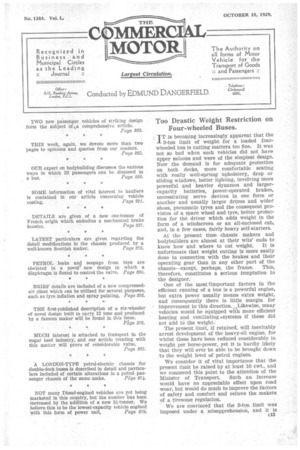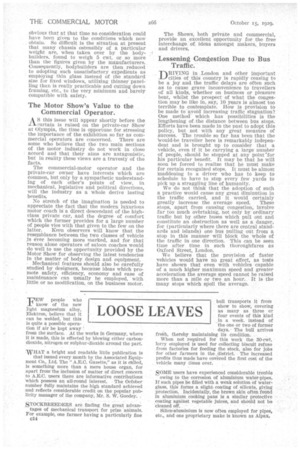Too Drastic Weight Restriction on Four-wheeled Buses.
Page 51

Page 52

If you've noticed an error in this article please click here to report it so we can fix it.
TT is becoming increasingly apparent that the J9-ton limit of weight for a loaded fourwheeled bus Is cutting matters too fine. It was not so bad when such vehicles did not have upper saloons and were of the simplest design. Now the demand is for adequate protection on both decks, more comfortable seating with really well-sprung upholstery, drop or sliding windows, better lighting, involving more powerful and heavier dynamos and largercapacity batteries, power-operated brakes, necessitating servo devices in one form or another and usually larger drums and wider shoes, pneumatic tyres and the consequent provision of a spare wheel and tyre, better protection for the driver which adds weight in the form of a windscreen or an all-enclosed cab, and, in a few cases, fairly heavy self-starters.
At the present time chassis makers and bodYbuilders are almost at their wits' ends to know how and where to cut weight. It is unfortunate that weight cutting is more easily done in connection with the brakes and their operating gear than in any other part of the chassis—except, perhaps, the frame. This, therefore, constitutes a serious temptation to the designer.
One of the most ilimportant factors in the efficient running of a bus is a powerful engine, but extra power usually means extra weight, and consequently there is little margin for Improvement in this direction. Likewise, many vehicles would be equipped with more efficient heating and ventilating 0,systems if these did not add to the weight.; The present limit, if retained, will inevitably arrest development of the heavy-oil engine, for whilst these have been reduced considerably In 'weight per horse-power, yet it is hardly likely that they will ever be able to be brought down to the weight level of petrol engines.
We consider it of vital importance that the present limit be raised by at least 10 cwt., and we commend this point to the attention of the Minister of Transport. Such an increase would have no appreciable effect upon road wear, but would do much to improve the factors of safety and comfort and relieve the makers of a tiresome regulation.
We are convinced that the 9-ton limit was imposed under a misapprehension, and it is c13 obvious that at that time no consideration could have been given to the conditions which now obtain. So difficult is the situation at present that many chassis ostensibly of a particular weight are, when taken over by the bodybuilders. found to weigh 5 cwt. or so more than the figures given by the manufacturers. Consequently, bodybuilders are then reduced to adopting such unsatisfactory expedients as empt6ying thin glass instead of the standard size for fixed windows,, utilizing thinner panelling than is really practicable and cutting down framing, etc., to the very minimum and barely compatible with safety.
The Motor Show's Value to the Commercial Operator.
A S this issue will appear shortly before the XI-curtain is raised on the private-car Show at Olympia, the time is opportune for stressing the importance of the exhibition so far as commercial operators are concerned. There are some who believe that the two main sections of the motor Industry do not work in close accord and that their aims are antagonistic, but in reality these views are a travesty of the facts. The commercial-motor operator and the private-car owner have interests which are common, but only by a sympathetic understanding of each other's points of view, in mechanical, legislative and, political directions, will the industry as a whole derive lasting benefits. No stretch of the imagination is needed to appreciate the fact that the modern luxurious motor coach is a direct descendant of the highclass private car, and the degree of comfort which the former provides for a large number of people vies with that given to the few on the latter. Keen observers will know that the resemblance between the two classes of vehicle is ever becoming more marked, and for that reason alone operators of saloon coaches would do well to use the opportunity provided by the Motor Show for observing the latest tendencies in the matter of body, design and equipment. Mechanical features should also be carefully studied by designers, because ideas which promote safety, efficiency, economy and ease of maintenance can usually be employed, • with little or no modification, on the business motor. The Shows, both private and commercial, provide an ,excellent opportunity for the free interchange of ideas amongst makers, buyers and drivers.
Lessening Congestion Due to Bus Traffic.:.'
TARIVING in London and other Important JJ cities of this country is rapidly ceasing to be a joy and the traffic delays are often such as to cause grave inconvenience to travellers of all kinds, whether on business or pleasure bent, whilst the prospect of what the congestion may be like in, say, 10 years is almost too terrible to contemplate. How is provision to be made to 'avoid increasing traffic stagnation? One method' which has possibilities is the lengthening of the distance between bus stops. Efforts have been made in the past to adopt this policy, but not with any great measure of Success. The trouble so far has been that the Lwould-be traveller here is remarkably independent and is brought up to consider that a vehicle, even if it be carrying a large number of people, should be stopped at any point'for his particular benefit. It may be that he will soon be forced to realize that he must make for certain recognized stops. It must be almost Maddening to a driver who has to keep to schedule to have to stop every few yards to pick up a straggling line of humanity. We do not think that the adoption of such a practice would cause any great diminution in the traffic carried, and it would certainly greatly increase the average speed. These stops, apart from causing congestion, involve far too much ov6rtaking, not only by ordinary traffic but by other buses which pull out and constitute an obstruction as well as a danger, for (particularly where there are central standards and islands) one bus pulling out from a stop in this manner will block the whole of the traffic in one direction. This can be seen time after time in such thoroughfares as Oxford Street, London. We -believe that the provision of faster vehicles would have no great effect, as tests have shown that even with vehicles capable of a much higher maximum speed and greater acceleration the average speed cannot be raised more than a mile or two an hour. It is the many stops which spoil the average.




























































































































